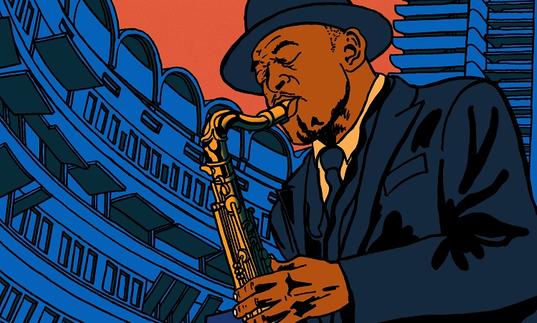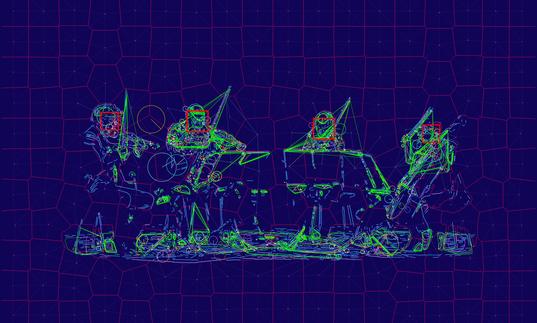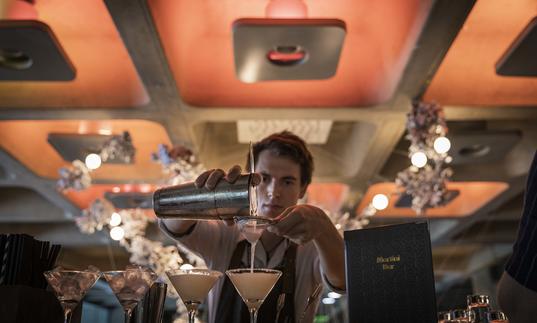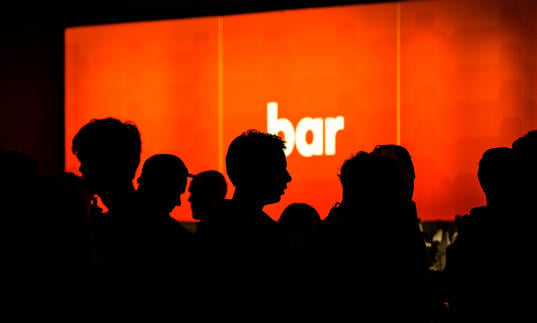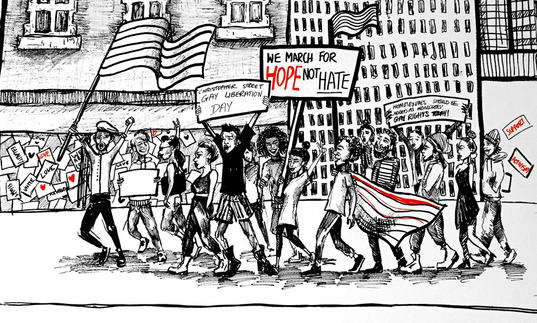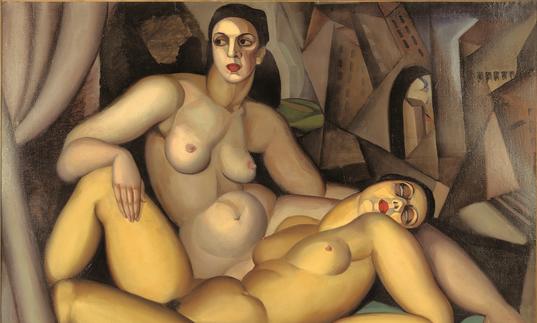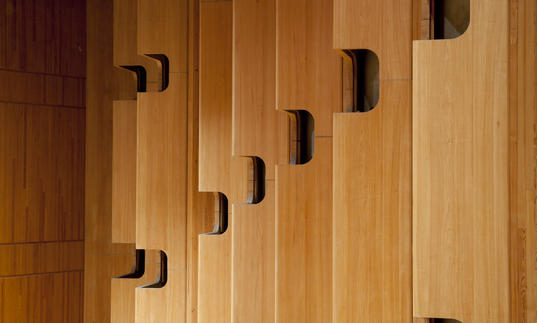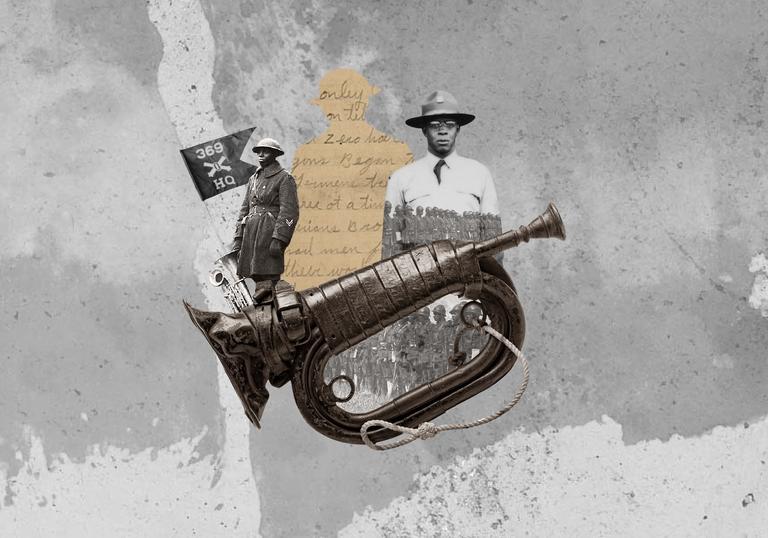
Performers
Jason Moran piano
The Bandwagon
Tarus Mateen bass
Nasheet Waits drums
Tomorrow's Warriors
Ife Ogunjobi trumpet
Joe Bristow trombone
Hanna Mubya bass trombone
Mebrakh Johnson reeds
Kaidi Akinnibi reeds
Alam Nathan reeds
Andy Grappy tuba
Bradford Young cinematographer
Stefani Saintonge film editor
Harbor Picture Company colour correction
Jati Lindsay still photography
Bill Strode sound engineer
Jack Jordan AV engineer
Part of The Art of Change
Our 2018 season explores how the arts respond to, reflect and potentially effect change in the social and political landscape.
Discover
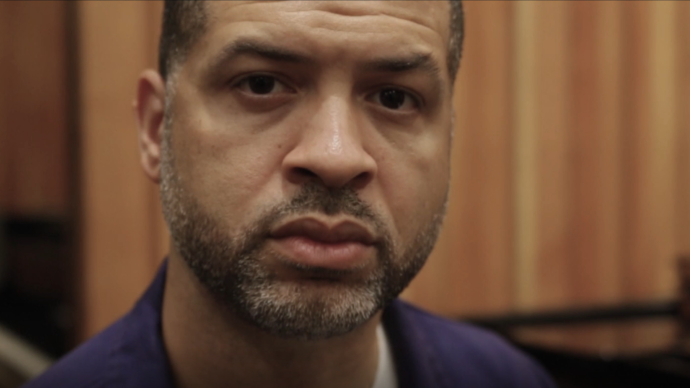
Barbican Meets: Jason Moran
Composer, pianist and visual artist Jason Moran talks to us about early jazz pioneer and African American soldier, James Reese Europe.
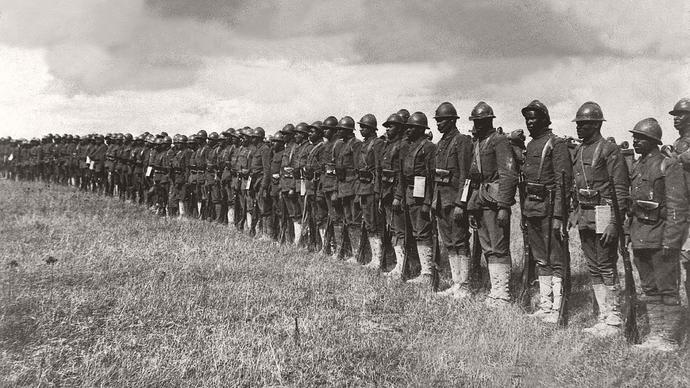
Long read: Music of conflict
Dr Kate Kennedy looks at a number of solider-composers from World War I, from different backgrounds and nations, exploring the vital importance of music for survival.
A word from Jason
There is great beauty in the life of Lieutenant James Reese Europe. Within the scholarship of who he was and what his music is, it becomes clear that the history surrounding him is a complex and tightly woven knot. Each strand of the cord holds a uniquely American history, a history that also births another complex knot, jazz.
Europe becomes a freedom fighter. He learns aspects of this at an early age as his violin teacher is the son of the great abolitionist Frederick Douglass. An early lesson he understands is that sound and freedom aid one another. With his violin he arrives New York on a mission. Much of this mission revolves around music, but his greater mission will be that of demanding equality of African-American performers, people. He finds fame by producing music for many societies: dances, parties, ceremonies, concerts. In 1910 he formed the groundbreaking Clef Club, a union for African-American musicians. His 1911 standing room only Carnegie Hall premiere of the Clef Club Orchestra was a sensation. His work developing dance music with the famous dancing duo, Vernon and Irene Castle, innovated the fox trot tempos and other dance steps. With each of these developments Europe always found a larger stage. The 'stage' will always be a portal, a place to test what is real and surreal.
In World War One he found his largest and most dangerous stage. When he joined the New York's 15th Regiment, later becoming the 369th Infrantry Harlem Hellfighters, he knew African-American soldiers could not fight alongside white soldiers. His writing partner Noble Sissle was shocked Europe signed up. Sissle asked Europe if he could get out of the war, would he? Europe replied 'If I could, I would not. My country called me and I must answer. And if I live to come back, I will startle the world with my music.'
He indeed startled the world. 100 years later we celebrate a brave individual among a company of soldiers, The Harlem Hellfighters, who predicted a thought Martin Luther King Jr. would write some 47 years later in his letter from a Birmingham jail 'Injustice anywhere is a threat to justice everywhere.'
Here We Are.
Jason Moran
A word from the event producers
On New Year’s Day 1918, James Reese Europe – an iconic figure in the evolution of African-American music – landed in Brest with the Harlem Hellfighters. As well as their achievements in combat, Europe’s crack military music ensemble popularised the new spirit of jazz to a war-torn French nation fascinated with black culture. And this is but the beginning of a story that continues to fascinate and intrigue.
Tonight’s performance is the culmination of months of research and discovery, from early conversations between 14-18 NOW, Serious and the Kennedy Center in Washington DC – where, crucially, composer and bandleader Jason Moran is Artistic Director for Jazz, and has brought in a creative team that includes film-makers John Akomfrah and Bradford Young. As the project has evolved, more partners have joined up – the Barbican in London, Jazzfest Berlin, Renfrewshire Leisure and the Royal Welsh College of Music and Drama in Cardiff.
The performing group itself is a dynamic transatlantic mix, with Jason Moran’s long established trio, the Bandwagon (Tarus Mateen, Nasheet Waits) at its heart. Jason was keen to involve a players who correspond to the generation that signed up for the original Hellfighters – the UK musicians are drawn from the alumni of Tomorrow’s Warriors, with the help of their Artistic Director, Gary Crosby. The line-up is completed by Andy Grappy, who has also been leading a parallel project to introduce teenage musicians at each venue on the tour to James Reese Europe’s original music.
Serious, October 2018
Jason Moran’s new work celebrates a lost hero of African-American music: James Reese Europe, whose band brought the spirit of jazz across the Atlantic during the final turbulent year of the First World War. It’s a fascinating tale – and in musician Jason Moran and visual artists John Akomfrah and Bradford Young, it has found its perfect storytellers.
The Harlem Hellfighters: James Reese Europe and the Absence of Ruin is part of the final season of 14-18 NOW, the UK’s arts programme for the First World War centenary. Over the last five years, we have invited more than 300 UK and international artists, in every genre and style, to create new works that explore the global impact of the First World War and its resonance today.
Every 14-18 NOW project has collaboration at its core, and this is no exception. Our thanks go to Serious, the Berliner Festspiele / Jazzfest Berlin and the John F. Kennedy Center for the Performing Arts, our co-commissioning partners; to the Barbican Centre, Renfrewshire Leisure and the Royal Welsh College of Music & Drama for presenting the work in the UK; and to the National Lottery through Arts Council England and the Heritage Lottery Fund, the Department for Digital, Culture, Media and Sport, and the Federal Agency for Civic Education in Germany, the project’s supporters. Above all else, our huge thanks to Jason Moran, John Akomfrah and the entire creative team behind this remarkable project.
14-18 NOW continues until the end of the year with events including Pages of the Sea, a special nationwide event created by Danny Boyle on beaches around the UK on Sunday 11 November to mark 100 years since Armistice. For more information about this and all our projects, please visit our website.
Jenny Waldman, Director, 14-18 NOW
Barbican Hall
Location
The Barbican Hall is located within the main Barbican building. Head to Level G and follow the signs to find your seating level.
Address
Barbican Centre
Silk Street, London
EC2Y 8DS
Public transport
The Barbican is widely accessible by bus, tube, train and by foot or bicycle. Plan your journey and find more route information in ‘Your Visit’ or book your car parking space in advance.
Credits
Co-commissioned by 14-18 NOW: WW1 Centenary Art Commissions, Berliner Festspiele / Jazzfest Berlin, Serious and the John F. Kennedy Center for Performing Arts, with support from the National Lottery through Arts Council England and the Heritage Lottery Fund, from the Department for Digital, Culture, Media and Sport and from the Federal Agency for Civic Education, Germany.
Co-produced Berliner Festspiele / Jazzfest Berlin
Produced by the Barbican in association with Serious
The producers would also like to thank Louise Holland, Miles Evans PR, the British Library, Professor Catherine Tackley, Tom Perchard, Fraser Kennedy, Gary Crosby and the teams at Serious and 14-18 NOW for helping to bring this project to fruition.
